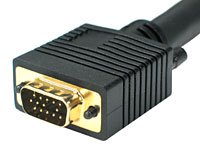The PC that you have at home will generally have a minimum of four components - these are the monitor, the keyboard, the mouse and the system case. Today we're going to briefly visit monitors and we'll cover the other components in the coming days.
The monitor is the part of the computer that you spend most of your time interacting with so make sure that the one you have is easy on your eyes and correctly set up. Up to 2 years ago the commonest type of monitor was cathode ray tube (CRT)-based - using similar technology to standard TV sets.

 These monitors can give very good pictures but suffer from being bulky, especially those with a screen size over 17", and they consume quite a bit of power. CRTs are being phased out and now it is almost impossible to buy one, except very expensive high-end units used for critical colour work. They have been replaced by LCD flat screen monitors that take up much less desk space and use a lot less power. Typically these are 17" or 19" diagonally across from top-left to bottom-right and prices have fallen dramatically over the past 12 months - you can now but a 17" model for just over €200.
These monitors can give very good pictures but suffer from being bulky, especially those with a screen size over 17", and they consume quite a bit of power. CRTs are being phased out and now it is almost impossible to buy one, except very expensive high-end units used for critical colour work. They have been replaced by LCD flat screen monitors that take up much less desk space and use a lot less power. Typically these are 17" or 19" diagonally across from top-left to bottom-right and prices have fallen dramatically over the past 12 months - you can now but a 17" model for just over €200.As well as a power cable your monitor will have a cable with one of two types of connector at the end. CRT monitors and cheaper LCD will have a 15-pin D-Sub connector (although there will probably only be 14 pins present) and this is connected to a corresponding female socket, which

 is almost always coloured blue) on the back of your system case. More expensive LCD monitors will have a cable with a beige DVI (digital video interface) connector that mates with a beige female connector on the back of your system case. The DVI connector keeps the picture in the digital realm as it passes from the computers graphics processor to the monitor. On the otherhand, the D-Sub connector handles a signal that has been converted from digital to analog. In theory the DVI cable (and the graphics processor that it is connected to) should give a better picture, however,
is almost always coloured blue) on the back of your system case. More expensive LCD monitors will have a cable with a beige DVI (digital video interface) connector that mates with a beige female connector on the back of your system case. The DVI connector keeps the picture in the digital realm as it passes from the computers graphics processor to the monitor. On the otherhand, the D-Sub connector handles a signal that has been converted from digital to analog. In theory the DVI cable (and the graphics processor that it is connected to) should give a better picture, however, 
What we commonly see in home PCs are monitors that are poorly set up, particularly CRTs. There are three important things to consider with CRT monitors - the screen refresh rate, the picture geometry and the screen resolution. Screen refresh rate is how many times a second the image is redrawn on a CRT. If this is too low, say 60 Hz, you may find that the screen appears to flicker and this will lead to eye strain after some time. Your screen should be set to the highest refresh rate supported by your monitor, in line with the manufacturer's guidelines (see handbook that came with monitor). Screen geometry is how the picture is aligned on the screen and this can normally be changed by using a combination of buttons on the front of the monitor together with an on-screen display (OSD.). Using the OSD you should be able to adjust the horizontal and vertical size of the display (commonly badly set up by users leading to an under utilized screen with a dark edge around one or more sides of the screen) as well as picture position and correct for barrel and pin-cushion distortion. Screen resolution dictates how many pixels, or dots that compose the image, are present on the screen. A low resolution, say 600x800, on a 19" monitor will mean a very chunky display that requires much scrolling to see the full image. Conversely, a resolution of 1200x1600 on a 15" screen (if supported) will lead to a highly detailed screen but with the characters and icons too small to be easily readable. My own preference is for resolutions of 1024x768 for a 15" screen, and 1200x1600 for a 17"-19" screen.
Refresh rate and geometry settings are not relevant for LCDs but screen resolution is, so find the optimum level for your screen.
Next up, of mice and keyboards.
No comments:
Post a Comment